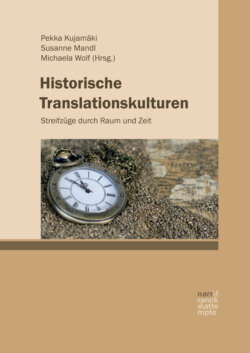Читать книгу Historische Translationskulturen - Группа авторов - Страница 42
3.5 Celtic translation culture(s)
ОглавлениеBased on the above analyses of translation traditions in the Celtic regions, the most striking similarity between these traditions during the Celtic Revival was the trend towards translating from the Celtic language into English (or French in the case of Breton) rather than into the Celtic language. This was due to the fact that English had become the predominant language in the British Isles and, thus, the medium which made texts available to the widest audience, although English was seen as the language of the colonising power by many. It also made texts accessible to an international audience interested in Celticism. However, the key aim of many of these translations was to allow people in the Anglicised parts of the Celtic regions to learn more about their cultural heritage and literature and the majority were ancient legends, tales and poetry, published almost exclusively as anthologies, as was the case throughout much of Europe at the time (see e.g. Seruya et al. 2013). In Wales and Ireland, also contemporary literature was translated into English which included self-translations by the authors themselves, such as Douglas Hyde, but also translations of contemporary literature which were included in anthologies alongside medieval literature.
Another reason why translators focussed on ancient literature was to recreate the image of Celtic culture for this new audience. This led to a situation where the hegemonial language which had become dominant in the British Isles was reclaimed by the colonised people for their own purpose. Concerning the use of language in a colonial situation, Ashcroft, Griffiths and Tiffin, who investigate the language use in the British Empire and its colonies, make a distinction between abrogation and appropriation – abrogation meaning the absolute denial of the language of the hegemonial power by the colonised people while appropriation is understood as the use of the hegemonial language by the colonised people in their own interest (Ashcroft et al. 1989: 38–40). Many of the translations which were written during the Celtic Revival were very literal, retaining the original syntax and idiom; English as a language was colonised. As a result, Hiberno-English emerged as a literary vernacular, it was appropriated. Efforts were made to also retain the style of the original, which often resulted in the use of archaisms in order to convey the antiquity of the texts. A further translation strategy involved writing metrical translations, which made certain adaptations to the text necessary.
At the time, universities started to play an important role in Celtic language translation. The emergence of Celtic Studies as a university subject increased the demand for English-language versions of Celtic literature. As the main function of these texts was to serve as material for academic analysis, they needed to be quite literal for scholars who were not fluent in the language(s).
Despite similarities between the translation cultures during this movement, there are certainly also many differences. The status and usage of the languages under investigation, for example, varied to some extent. Additionally, there appear to be no clear patterns in relation to who the translators were during the Celtic Revival. However, to explore the parallels and differences between the translation cultures of each of the Celtic regions would be beyond the scope of this paper. Looking at languages can be a way of moving away from nations’ borders and allows for a more integrated approach concerning the translation history of the British Isles when analysing translation processes between all languages involved.
